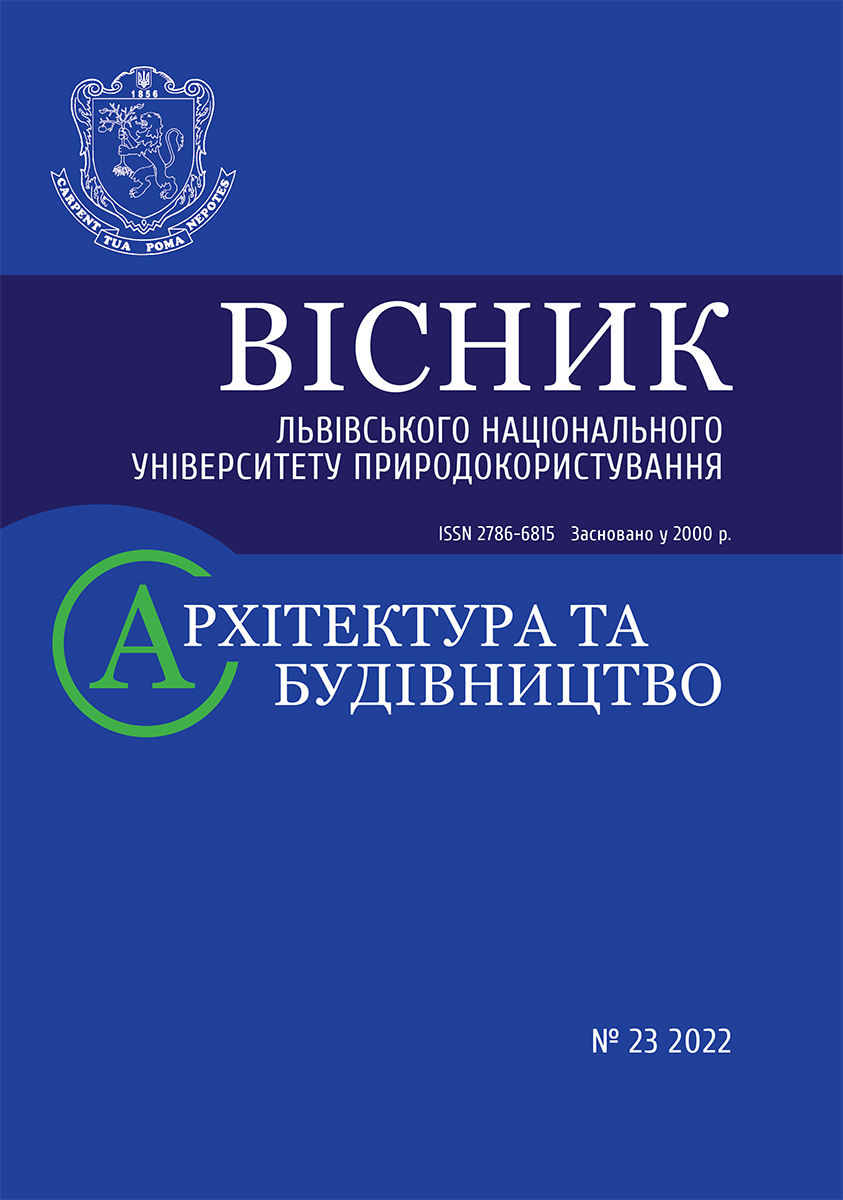MODELING OF THE STRESS STATE IN THIN ISOTROPIC PLATES
DOI:
https://doi.org/10.31734/architecture2022.23.005Keywords:
mathematical model, thin isotropic plates, automatic differentiationAbstract
A method of calculating the stress state in thin isotropic rectangular arbitrarily loaded plates for various boundary conditions has been developed.
Solution of the problem is reduced to solution of a differential equation of the fourth order in particular derivatives
, (1)
where is Laplace’s differential operator; w – deflection of the plate; q – transverse load applied to the upper surface of the plate and D is bending rigidity of the plate.
Solution of the equation (1) is presented in the form of a sum of its particular solution w⁎ and the general solution wо of corresponding uniform equation
(2)
General solution wо is presented as a sum of products of unknown coefficients and shape functions .
(3)
Coefficients are treated as degrees of freedom of the plate.
Similarly, a particular solution is given as a sum of products of force functions and other unknown coefficients.
Such approach allows to satisfy conditions at the edge and on the surface of the plate.
Boundary conditions are performed in the separate nodes at the plate edge (in each node two boundary conditions are written). In each node on the plate surface only one condition is written.
A program which automatically generates and places nodes at the edge and on the surface of the plate has been developed.
The expression (3) is called a function of the plate deflection state. State functions of other static and kinematic quantities are obtained from formula (3) by Automatic Differentiation.
Distributions of deflection, tangent displacements, moments and shearing forces are obtained on the whole area of the plate.
In this paper, two variants of the plate are considered: symmetrical and nonsymmetrical one. A plate is considered symmetrical if it satisfies the conditions of symmetry of the plate contour and boundary conditions also the conditions of symmetry of the external load and mechanical properties. Although if one of them is not performed the plate is nonsymmetrical.
For a symmetrical plate, the results are presented in the form of plots built in the central and edge cross sections of the plate. The results are compared with numerical ones obtained with the help of Package ABEQUS in the form of space plots.
It is shown that kinematic boundary conditions are performed exactly with analytical and numerical approaches. Instant results are not coincided as statistical boundary ones.
For nonsymmetrical plates, the results are given in the form of contour plots on the whole area of the plate.
References
Barthelemy J.-F. M., Hall L. E. Automatic differentiation as a tool in engineering design. Structural optimization 9.2 (Apr. 1995). Р. 76–82. URL: ttps://doi.org/10.1007/BF01758823. (Аccessed 02 June 2022).
Baydin A. G., Pearlmutter B. A., Radul A. A. Automatic differentiation in machine learning: a survey. The Journal of Machine Learning Research, 2018.
Bradbury J., Frostig R., Hawkins P., Matthew J. Johnson, Leary Ch., Maclaurin Dougal, Wanderman-Milne Skye. JAX: composable transformations of Python+NumPy programs. Version 0.1.55. 2018. URL: http://github.com/google/jax. (Аccessed 02 June 2022).
Brian M. Donning, Wing Kam Liu. Meshless methods for shear-deformable beams and plates. Computer Methods in Applied Mechanics and Engineering 152.1. 1998. Containing papers presented at the Symposium on Advances in Computational Mechanics. Р. 47–71. URL: http: //www.sciencedirect.com/science/article/pii/S0045782597001813 (Аccessed 02 June 2022).
Deliavskyi M., Rosiński K. Solution of non-rectangular plates with microelement method. AIP Conference Proceedings 1822.1. 2017.
Deliavskyi M., Rosiński K. The New Approach to Analysis of Thin Isotropic Symmetrical Plates. Applied Sciences 10.17. 2020. URL: https://www.mdpi.com/2076-3417/10/17/5931 (Аccessed 02 June 2022).
Malekan M., Barros. F. B., Roque L. S. Pitangueira, Phillipe D. Alves. An Object-Oriented Class Organization for Global-Local Generalized Finite Element Method. Latin American Journal of Solids and Structures 13. Dec. 2016. Р. 2529–2551. URL: http://www.scielo.br/scielo.php?script=sci_arttext&pid=S1679-78252016001302529&nrm=iso. (Аccessed 02 June 2022).
Mohammad M., Felício B., Roque P., Phillipe A., Samuel P. A computational framework for a two-scale generalized/extended finite element method: Generic imposition of boundary conditions. Engineering Computations 34. Aug. 2016.
Ning L., Ann E. Jeffers. A geometrically exact isogeometric Kirchhoff plate: Featurepreserving automatic meshing and C1 rational triangular Bézier spline discretizations. International Journal for Numerical Methods in Engineering 115.3. 2018. Р. 395–409. URL: https://onlinelibrary.wiley.com/doi/abs/10.1002/nme.5809. (Аccessed 02 June 2022).
Pavlou D. G. Main Disadvantages of Finite Element Method. Essentials of the Finite Element Method for Mechanical and Structural Engineers. Elsevier Inc., 2015.
Rakowski G., Kasperczyk Zb. Metoda elementów skończonych w mechanice konstrukcji. Oficyna Wydawnicza Politechniki Warszawskiej, 2005.
Reddy J. N. An Introduction to the Finite Element Method, 3rd ed. New York: McGraw-Hill, 2006.
Reddy J. N. Energy Principles and Variational Methods in Applied Mechanics, 3rd edition. New York, United States of America: John Wiley & Sons, Inc., 2017.
Reddy J. N. Theory of elastic plates and shells. Second Edition. London, New York: CRC Press Taylor & Francis Group, 2010.
Szilard R. Theories and Applications of Plate Analysis. Classical, Numerical and Engineering Methods, 2004.
The Finite Element Method for Solid and Structural Mechanics. The Finite Element Method for Solid and Structural Mechanics (Seventh Edition). Ed. by O. C. Zienkiewicz, R. L. Taylor, and David Fox. Seventh Edition. Oxford: Butterworth-Heinemann, 2014. URL: http: //www.sciencedirect.com/science/article/pii/B9781856176347000168 (Аccessed 02 June 2022).
Varun G., Dae-Jin K., Duarte C. A. Analysis and improvements of global–local enrichments for the Generalized Finite Element Method. Computer Methods in Applied Mechanics and Engineering. 2012. Р. 47–62. URL: http://www.sciencedirect.com/science/article/pii/S0045782512002186 (Аccessed 02 June 2022).
Wenting Shao and Xionghua Wu. Chebyshev tau meshless method based on the highest derivative for solving a class of two-dimensional parabolic problems. WIT Transactions on Modelling and Simulation. Oct. 2013.
Zienkiewicz O. C., Taylor R. L. The finite element method, 5th ed. Vol. 2. Oxford: Butterworth Heinemann, 2000.
Zu-Qing Qu. Model Order Reduction Techniques with Applications in Finite Element Analysis. In: London: Springer-Verlag, 2004.


